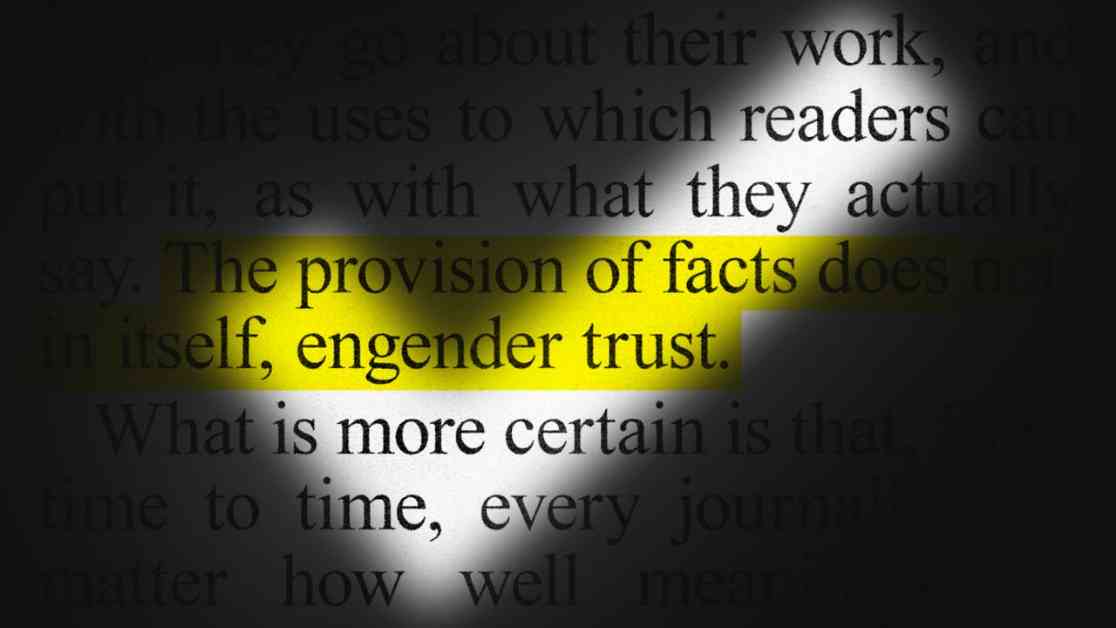Understanding the Concept of Facts: A Comprehensive Guide
Every tribe has its myths, and journalists are no exception. In America, one common story goes like this: once, in the prelapsarian era before social media—or before smartphones, or the Internet—there was a time when journalists were trusted. Back then, everybody read muscular daily newspapers and watched straight-down-the-line TV reporting. When citizens had to make political decisions, a robust social contract with the media insured that they were well informed; even if they couldn’t always agree on what to do or whom to vote for, they could rely on a shared set of facts. But then something changed: people stopped paying attention to the news, or decided that they didn’t believe it anymore. They got distracted by podcasts, Facebook, and Twitch. They became ill-informed, and started to act against their best interests. The media decayed and fragmented, along with the nation. Opinion and news became indistinguishable, misinformation ran amok, and that is how we came to live in the post-truth world.
Trust in many institutions has fallen over the years, but in journalism, it has plummeted. In 1972, Gallup began asking people in the United States, “How much trust and confidence do you have in the mass media?” The numbers used to be highly favorable—in 1976, more than seventy per cent said they had a lot, and very few reported having none—but in 2024 a plurality of respondents (thirty-six per cent) said that they had “none at all.” A survey of how highly Americans rated the ethics of various professions found that only a fifth believed journalists’ standards were “high” or “very high”: a better ranking than car salespeople and senators, but worse than bankers and chiropractors. (Almost half said that journalists’ standards were “low” or “very low.”) Increasing numbers of Americans report not following the news, or doing so via factually unreliable social or alternative media. In some parts of the world, the picture looks rosier—the Nordic states, outliers as ever, have far higher levels of public trust in journalism—but one recent study of twenty-eight countries showed the balance of media trust and distrust to be neutral at best, and negative among the most developed nations.
Meanwhile, large swaths of the industry have been on the retreat, racked by dwindling advertising revenue, hostile governments, and declining audiences. In the United States, the number of people employed in newsrooms dropped by more than a quarter between 2008 and 2020; thousands were laid off in 2024 alone. In 2022-23, the Committee to Protect Journalists recorded more journalists jailed worldwide than ever before. Technological change—most recently and acutely the mainstreaming of generative artificial intelligence—presents its own challenges, as does political polarization. In the United States, for example, the erosion of trust in journalism has been sharper and more consistent among Republican voters, and it can seem, in both parties, that many people turn to the news more for affirmation than for information. What passes for truth often depends on where one falls on the political spectrum: it’s no coincidence that Donald Trump’s venture into social media has “truth” in its name.
Widespread Recognition of Misinformation
One answer has been to turn up the volume: to loudly pronounce that, in a fallen world, only we can provide accuracy. Networks such as NBC and the BBC have launched units dedicated to fact-checking what other people say—as opposed to checking their own work—and for the first Presidential debate of 2024, the New York Times tasked twenty-nine staffers with combing through the candidates’ statements in real time. Not every entrant in the accuracy economy is as large or well-resourced: in the past decade, hundreds of small fact-checking websites have sprung up around the world, including many in countries, such as India, where press freedom is far from a guarantee.
The Pursuit of Accuracy
The New Yorker is known for its accuracy. At least, that’s what the magazine tells itself. In reality, it depends on whom you ask. A prospectus announcing the first issue of The New Yorker, in 1925, promised that: As compared to the newspaper, The New Yorker will be interpretative rather than stenographic. It will print facts that it will have to go behind the scenes to get, but it will not deal in scandal for the sake of scandal nor sensation for the sake of sensation. Its integrity will be above suspicion. True to this mandate, The New Yorker maintains an obsessive interest in facts, and it didn’t take long for the early editors to recognize the usefulness of at least basic stenography. In 1927, the magazine published a Profile of the poet Edna St. Vincent Millay, “America’s first starlet.” Its first sentence—“Edna Millay’s father was a stevedore on the wharves at Rockland, Maine”—sounded good, but, like plenty more in the piece, it wasn’t true: Millay’s father was a schoolteacher turned insurance agent.
The Role of Fact-Checkers
But the pursuit of accuracy—that is, confirming a fact is a fact—is only part of the project. With a few pragmatic exceptions, fact checkers go over everything published by the magazine, editing for balance, fairness, and context. Writers are asked to share their sourcing; checkers review both research materials (books, articles, e-mails, documents) and original reporting. For complex topics, and as needed for corroboration, they do their own independent research, perhaps conferring with relevant experts. And, unless there’s a good reason not to, they get in touch with every person and entity discussed in the story, and comb through what’s attributed to or said about them.












